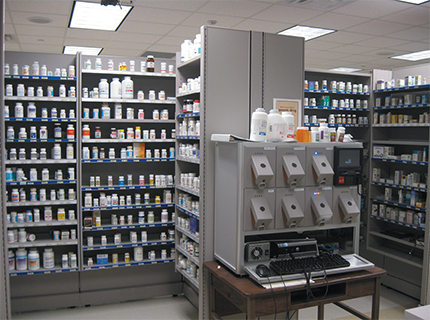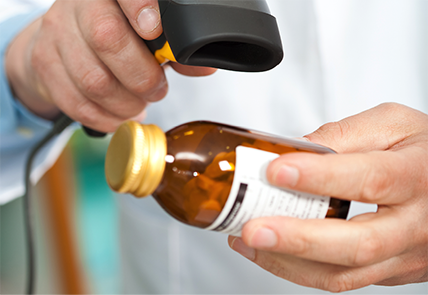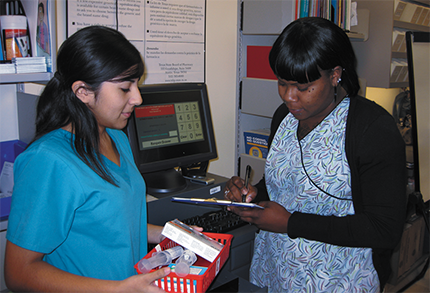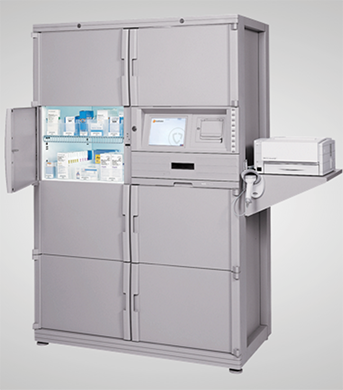11.5 Inventory Management
Inventory control is an important task for the hospital pharmacy technician. Since up to 70% or more of the department budget is spent on pharmaceuticals, the efficient turnover and accurate tracking of inventory are extremely important responsibilities. Many hospital pharmacies have assigned inventory management to a senior pharmacy technician. This individual (with the assistance of the drug-information pharmacist) assumes the position of the pharmaceutical buyer and is responsible for helping to prepare contracts and bids, ordering the medications, and receiving shipments of these ordered items. These technician duties are performed under pharmacist supervision.
Information technology greatly assists the technician in meeting and adjusting drug inventory. In addition to pharmaceuticals, the budget often includes IV solutions, bulk ingredients, administration sets, and pumps, as well as various other medical supplies. Pharmacy storage space is often limited, so managing to have sufficient inventory without shortages is essential to providing good patient care. For this reason, hospital pharmacy personnel usually perform a physical inventory of their drugs annually.

Drug inventory comprises a majority of the hospital pharmacy budget and must be carefully monitored and tracked.
Bidding Pharmaceuticals and Purchasing Contracts
The pharmacy department must ensure that its patients receive the highest-quality pharmaceuticals at the lowest cost. Most hospital pharmacies order their pharmaceuticals from a prime vendor wholesaler (such as McKesson or Cardinal Health) and their IV solutions, ingredients, tubing, administration sets, and pumps directly from a specialty pharmaceutical compounding manufacturer. Software from the hospital pharmacy and the wholesaler makes inventory management more accurate and less costly.
Many large hospitals use an annual or biennial competitive, confidential, sealed-bid process for selecting the prime vendor wholesalers and manufacturers of drugs and IV solutions. The inventory-control technician is often responsible for collecting the information necessary for the drug-bidding process. For example, the technician may be asked to estimate the annual total hospital units for the antibiotic Zosyn in its many dose formulations or to estimate the number of cases of dextrose 5% in water (D5W) IV solutions for the next year. The technician with the pharmacists and the director must arrive at accurate estimates of the units needed of each of the many thousands of formulary drugs for the next calendar or fiscal year.
Most hospital pharmacies accept bids with a one year “lock in” of medication costs. Changing manufacturers of generic medications (or switching from brand name drugs to generics) too often may cause confusion for the pharmacist, nurse, and physician because the color, shape, or packaging may differ from that of the previously stocked medication. If the hospital operates an outpatient community pharmacy, many states require a separate bidding process and physical inventory.
Contracts with the IV compounder and supplies manufacturer are generally made for a longer period (typically five years). Switching IV solutions and IV administration sets requires massive re-education of nursing personnel, and completing this task on a yearly basis would be neither feasible nor cost-effective. Plus, constant fluctuation in IV solutions and equipment increases the risk of medication administration errors.
Ordering the Pharmaceuticals
Once bids and purchasing contracts are finalized, an important responsibility of the inventory control technician is ordering from these drug vendors. However, there are two situations in which special ordering may be required. Each situation is described below.
Nonformulary Drugs
Occasionally, a nonformulary drug must be purchased from a different wholesaler (or community pharmacy) if prescribed and approved for a specific use. Depending on hospital policy, the patient receiving the medication may be charged by the hospital for the bulk purchase (for example, a quantity of 100 tablets or capsules). The nonformulary drug is then repackaged by a technician into a unit dose formulation with a bar code for scanning by a nurse. If charged to the patient, any remaining medication is returned to the patient at discharge.

The pharmacists and pharmacy technicians use a handheld bar code scanner to track inventory usage in the pharmacy.
Drugs Borrowed from Other Facilities
At times, a hospital pharmacy may need to borrow a medication from another hospital or a community pharmacy. The P&P Manual will outline the process, and the borrowed drug must be returned when the next shipment is received from the wholesaler. Once the restitution has occurred, each facility’s inventory is settled at the month’s end. Of course, if controlled substances are borrowed, even more careful documentation with more signatures is required so that substantial proof is evident in case of an audit.
Receiving and Storing Drug Inventory
Once the regularly ordered drugs are received, the technician must check each drug in the order against the wholesaler’s or manufacturer’s invoice. The order must be reviewed for potentially damaged or expired goods. Unusable goods must be refused.
 Practice Tip
Practice Tip
Pharmacy and nursing refrigerators and freezers are designated solely for medication storage. No food or beverages can be stored alongside the medications.
If items are missing from the invoice, the technician alerts the pharmacist in charge of inventory. The wholesaler may not have been able to acquire the requested medication due to an FDA or manufacturer drug recall or a drug shortage. If the drug cannot be received in a timely manner, the pharmacist may need to notify the prescriber and help to find an alternative drug. Shortages for needed chemotherapy drugs and even IV fluids are not an uncommon problem. The inventory technician should also check special order deliveries (medications not routinely stocked) on a daily basis in case a patient is waiting for a newly received medication.
Whereas the inventory control technician is the one primarily responsible for purchasing and ordering medications, all pharmacy technicians assist in receiving, storing, and restocking the ordered items once they are verified by the invoice. Boxes of various IV solutions must be stored in a warehouse; they must be removed from boxes and wiped down before being placed in a designated area outside the IV cleanroom.

The pharmacy technician is responsible for delivering narcotics and any other controlled substances to each nursing unit floor stock. Each time the inventory must be checked and signed off by the nursing supervisor.
The technicians store the medications on their designated shelves, in the refrigerator, or in the freezer. The storage guidelines for each pharmaceutical can be found in the attached product package inserts or by consulting pharmaceutical references, such as the American Hospital Formulary Service Drug Information. Prior to storing the drugs, temperatures (in degrees Celsius) in the pharmacy and nursing refrigerator, freezer, and automated units should be documented per the hospital policy.
Special Handling of Certain Pharmaceuticals
Two types of pharmaceuticals require special consideration in inventory control: narcotics and investigational drugs.
 Practice Tip
Practice Tip
All unused, returned, damaged, or missing narcotics and other controlled substances must be recorded on a special DEA Form 106 signed by the pharmacist. An investigation will be conducted to make sure the missing drugs weren’t stolen.
Narcotics
The Controlled Substances Act (CSA) defines the proper processes for ordering inventory, filing, and record keeping for controlled substances. As in the community pharmacy, the purchase of Schedule II controlled substances must be authorized by a pharmacist and executed using the online or paper Drug Enforcement Administration DEA Form 222. Vendors also have DEA-approved online Controlled Substance Ordering Systems (CSOS). Unlike the receipt of other pharmaceuticals, the pharmacist must personally check in Schedule II substances, completing the DEA 222 receipt forms, and signing and filing the invoices. The pharmacist must check each Schedule II drug, dose, quantity, and NDC number.
 Pharm Fact
Pharm Fact
Hospitals that use automated narcotics storage reduce the time spent reconciling controlled substance inventory by more than 90%.
Multiple checks and balances exist for the secure storage and accountability of narcotics in the pharmacy as well as on the nursing units. As in the community pharmacy, all Schedule II controlled substances in a hospital pharmacy must be secured in a locked cabinet or safe. The pharmacist must conduct a physical inventory of Schedule II substances a minimum of every two years per DEA regulations. Any destruction of Schedule II drugs in the pharmacy or on the nursing unit must be witnessed and documented in the pharmacy department records. Returns of Schedule II drugs (due to theft, loss, or damage) are rare and must be recorded on a special DEA Form 106 signed by the pharmacist. Nurses must also maintain a Schedule II drug administration record on each unit to account for each dose of each Schedule II narcotic administered to a patient.
Since pharmacy technicians deliver controlled substances to nursing units, they are also responsible for reporting any unusual increases in inventory or discrepancies of nursing unit narcotics to the pharmacist. The pharmacist must immediately resolve any discrepancies with the nurse supervisor.

The Pyxis CIISafe is an example of an automated narcotic software system and vault that is used to store and track controlled substances in the central pharmacy.
NarcStation and Pyxis CIISafe are specialized AMDS units that may be used in the centralized pharmacy. They provide compatible software tracking systems using state-of-the-art bar code technology to maintain the record keeping, reporting, and transaction date for all controlled substances from the wholesaler to the patient. These systems also provide separate reporting for Schedule II, III, and IV drugs to meet DEA, state, and federal requirements. The software is compatible with many hospital systems and automatically reorders needed Schedule II drugs with an electronic sign-off for the DEA Form 222. Bar coding technology is used for receipt.
Automated dispensing systems offer perpetual inventory record keeping that continually updates the balance of remaining doses of each drug.
 Pharm Fact
Pharm Fact
An AMDS provides real-time reports and immediate access to information that identifies trends in controlled substance usage on each patient care unit.
Investigational Drugs
Pharmacy technicians also have the responsibility of storing investigational drugs under proper conditions (locked, refrigerated) and maintaining them separate from other hospital drug inventory. Investigational drugs require special ordering (directly from the manufacturer), handling, and record keeping procedures by the pharmacy technician. They may be received directly from the manufacturer or from a research department within the hospital.

Technicians need to rotate the stock and keep track of any low or missing stock.
Like controlled substances, investigational drugs must be maintained in a secure and separate area of the pharmacy, often a locked cabinet. They cannot be accessed without a valid written medication order received from the primary physician investigator. In most of these research studies, the drug is not labeled with a name or strength, but instead, the technician labels them with a drug study code, lot number, and expiration date. At the study’s conclusion, the technician in charge of storage returns all unused drug amounts, information, and data to the primary investigator.
Performing Ongoing Inventory Responsibilities
Besides correct storing of the inventory and documenting point of use, technicians have other hospital inventory responsibilities.
Rotating Inventory
As in the community pharmacy, shelf stock must be rotated so that the most recent inventory is not used first. Once a month, all technicians need to inspect all of the stock in the pharmacy and on the nursing units for expired drugs, including opened multidose vials of sterile water and normal saline in the pharmacy or on the nursing units. Automation may alert the technician to the lot numbers of drugs that will soon be out of date. Inventory turnover is rapid, and expired drugs rarely are found. Documentation for checking expired drugs in the pharmacy and nursing units is required for hospital accreditation.
Checking for Drug Recalls
Any medications recalled by the FDA or a manufacturer must be immediately pulled from the inventory shelves, unit dose carts, crash carts, automated filling and dispensing cabinets, and robots. A recall notice may come from the wholesaler or from a letter sent from the drug manufacturer to the director of pharmacy. The technician must compare the lot number of the drug in the recall notice with the inventory. Then, typically, the technician fills out, signs, and returns a form to the wholesaler indicating drug, strength, amount, and lot number to receive credit. A copy is kept in the pharmacy department records. (Drug recalls are also addressed in Chapter 2 on the laws involved and Chapter 14 on medication safety. It is important to know the many aspects of drug recalls, as they are likely part of the knowledge needed for certification exams.)